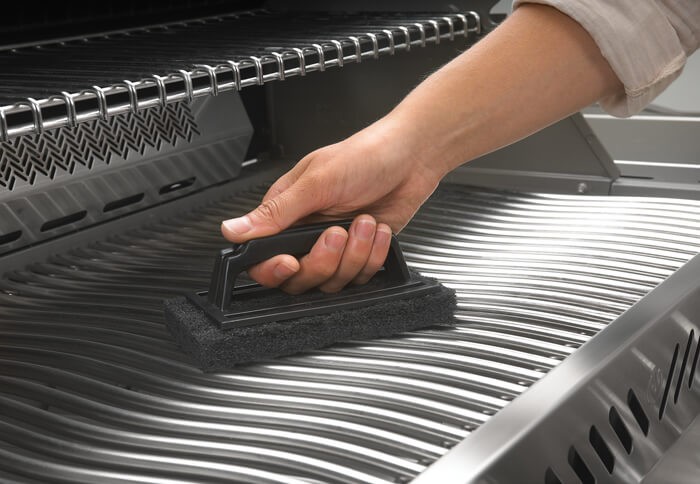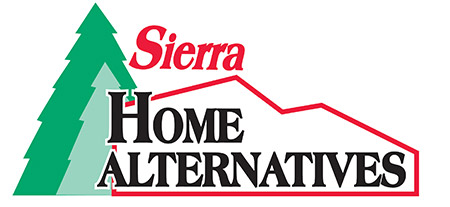A clean grill means good smells, good food and good times. A clean grill means no time lost to cook your meal.
Proper maintenance of your grill saves you time and money since your grill’s life expectancy will increase. It’s also a security measure, as food and grease build-ups can cause fires.
With the warm season just around the corner, you must be eager to take your grill out and put your chef’s hat on, so here are a few step-by-step solutions to help you with your grill maintenance.
After Every Use
To keep your grill in good shape and prevent food residue and grease build-up, it’s preferable that you clean it lightly after every use.
Turn the heat on high for 15 minutes or until the grill is no longer smoking, to burn off any food residue or grease.
With the grill still warm, turn off the gas and disconnect the tank.
Brush the grate with a grill brush or a crumpled-up piece of aluminum foil.
Wipe the exterior with soapy water, using dish cleaning soap.
Wipe off the soap with a damp cloth and dry thoroughly.
When the grill is not in use, keep it covered.
For a More Thorough Clean
If there is a tough residue build-up on your grill, here is what you can do.
Brush the grates and infrared panels (beneath the grates) to get any loose debris off, then remove them and soak them in a bucket of soapy water for at least 15 minutes.
Vacuum the bottom of your grill.
Light the grill and inspect the burner tubes to see if any are blocked. An orange flame instead of blue and reduced flame size are both signs that the tubes are blocked. If they are, turn the grill off and gently scrub the tubes with your grill brush. Brush from the centre of the tube outward, moving sideways, so as not to push the debris in the tube.
Remove the grates and panels from the bucket and scrub them with a long-handled grill brush.
Change the soapy water and wipe the exterior of your grill with a soft, damp cloth. If there are persistent stains, gently use a non-scratch scrubber. Wipe it down with microfibre towels.
As a finishing touch, you can use a stainless steel cleaner or vinegar to wipe down the stainless steel exterior.
For In-Depth Cleaning
A thorough semi-annual clean-up is necessary to keep your grill in good working condition.
Start by checking the fuel lines for cracks, holes or rips. If there are some, or if the line is bent, replace it.
Next, check the gas tank for dents, punctures or erosion. Replace it if you find some.
Now check the fuel lines for micro fissures. To do so, stir soap and water together until it gets sudsy. Brush the mixture on the fuel lines with a paintbrush. Turn on the gas and brush more of the mixture on the lines. If bubbles form, there’s a gas leak from a micro fissure. Replace the part immediately.
The ignition system is next. Turn the gas off, and test the ignition button to see if it makes a spark. If it does and lights correctly, and the pressure regulator on the gas tank tracks and maintains the right pressure, just turn the gas back on and light up the grill to finish testing it.
If there is no spark, check to see if the pressure regulator is secured tightly on the tank. Try to light the grill manually with a grill lighter. Remember to keep your face and arms away from the burners so as not to burn yourself. If your grill lights up, check the batteries in the ignition switch. Wipe off the electrodes to make sure there is no battery acid build up, and check your user manual to know more about dealing with batteries and electrodes.
Turn the gas off at the tank and disconnect it. You should do this every time you clean your grill to avoid gas leaks and fires.
Check the tank’s fuel level by pouring warm water on its side. It’s very important to pour the water on the side of the tank, not on top. Slide your hand down the wet side of the tank. The tank will be cooler where the fuel starts.
Next are the cooking grates. Brush them with a dry wire brush, then remove them and scrub their bottom side. Before scrubbing, you can use a barbecue grill cleaner or soak the grates in a more natural solution to make it easier. You will find natural cleaner recipes towards the end of the article. Once the grates are clean, spray vegetable oil on them to prevent rusting.
Remove the burner protectors—also called heat tents, vaporizer bars and flame tamers—and scrub them with a sponge and soapy water. If you see holes or a lot of rust, replace them.
Remove the venturi tubes—the pipes that go from the burners to the grill control valves—and clear out any debris or insects that might be inside by pouring water through it.
Wipe down the burners with a lightly moistened sponge. If the small holes in the burners are clogged, use a paperclip to clear them. If the holes are cracked, replace the burners.
Remove any debris from inside the grill using a grill brush, scouring pad or sharp putty knife. The debris will fall in the bottom tray. Once you’re done, remove the tray, throw away the debris, and wash the tray with water and soap. Rinse and dry it and put it back in its place.
To clean the exterior of your grill, use the appropriate cleaner for your grill whether it be stainless steel or porcelain.
Natural Solutions for Tough Stains
Some prefer not to use chemicals to clean their grill as it can affect the taste and smell of the food for a while, and can damage the grill’s finish.
If you prefer natural cleaners, here are a few recipes that you might want to try.
First up is the Water/Vinegar solution.
Mix 2 cups of white vinegar with 2 cups of lukewarm water in a spray bottle.
Spray the mixture on the grates and on the areas above and under until saturated. Let dry for 10 minutes.
Empty the remainder of your water/vinegar solution and refill the spray bottle with vinegar only.
Fold a sheet of aluminum foil until you have a two-inch square and spray it with vinegar.
You can now scrub the grill with it and don’t even need to rinse.
You can also use the water/vinegar solution on a cotton cloth to wipe down the exterior of your grill.
For even tougher stains, there is the Vinegar/Baking Soda solution.
Put your grates in a large plastic bag.
Stir one cup of vinegar with half a cup of baking soda and pour it on the grates.
Close the bag and leave the grates to soak overnight.
The next day, the grease and food residues should have loosened, so you can simply rinse them off. If any residue remains, use a grill brush to scrub it off.
To Your Grills
Now that grill maintenance holds no secrets for you, you’ll start the warm season with a sparkling grill. Your food will taste great and your friends and family will thank you for it. So, take out your apron and put on your chef’s hat. It’s time to get grilling!












1 Response